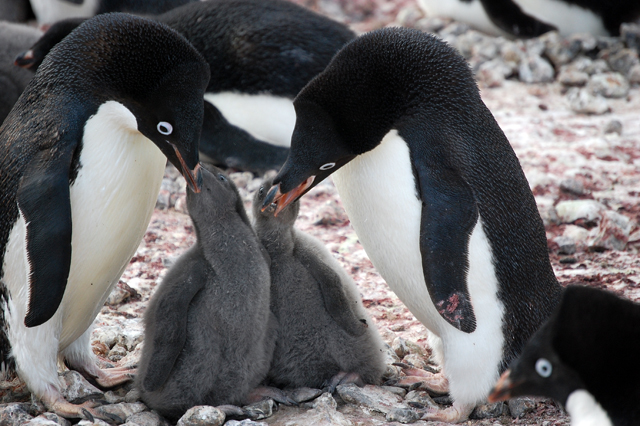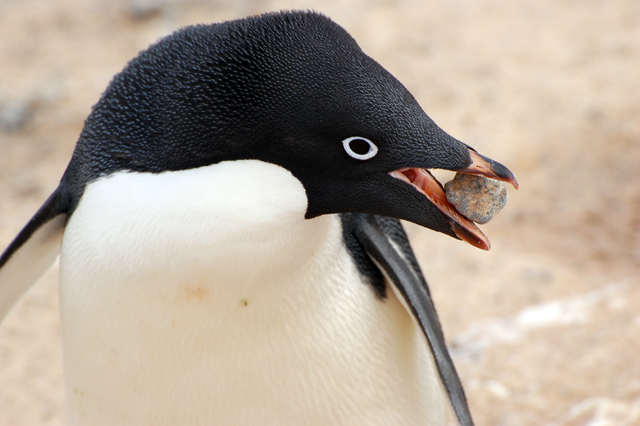Page 2/2 - Posted January 28, 2011
Penguins take life and death in strideWhen a mate returns to the nest a barrage of vocalization greets her. Scientific papers say it is for mate recognition. However, I know what it’s like to be hungry, grumpy and left home alone taking care of the chicks all day. Perhaps the communication goes along the lines of “Where have you been” or “You have been gone too long,” “Did you bring home enough food for everyone?” When the returning mate finally settles onto the nest, releasing the tired, hungry adult, the exchange continues with more chorus. “You are standing on the chicks,” “You are too far over there,” “Move your foot here.” I like to believe their exchange is more than merely recognition, as these birds interact with their mates through the exhaustive work of raising chicks. Penguins also yell at the kids. When my children were babies they could do no wrong, but by the time they were toddlers, rules and restrictions began to apply: crossing the street was not allowed. A newly hatched Adélie chick is helpless and spends much of its time under the body of the adult. By the time they are two weeks old, the world outside the nest looks exciting, and forays to the edge of the rock circle has appeal. But predatorial skuas and cold are ever present, and these chicks can’t defend themselves from either. Adults communicate loudly to their chicks and work them back into safety. As the chicks become older and bolder, adults must continue to beckon them back. Penguins clean up around the house. A pile of rocks is a castle to an Adélie, and maintenance is never ending. Tidying up around the nest is a constant battle, as rocks roll out, fall out, are kicked out, or stolen and need to be replaced. Before leaving on a foraging trip, a male will bring rocks one at a time to the nest, as if bringing a precious stone to its mate. He gently lays it near the nest for her to arrange as she wishes. Perhaps to promise, “I will return,” as he goes off to find food. There is one penguin family per nest, with nests arranged in neighborhoods. Nesting territory is respected, and violators are punished. But once away from home, penguins are gregarious and group oriented. Personal space becomes non-existent, and group dynamics are always entertaining. Food is in the ocean, but so is danger in the form of leopard seals. At the sea ice edge, no one wants to go in alone or be the first. Large numbers gather near the edge, and there is always a great deal of chattering and jostling as the group determines the time of entry. Hours of watching have not revealed what causes the group to dive in. But when they do, it is en mass. Does one push another, does one fall, or does one take the brave and daring lead, causing the others to follow blindly? Following a self-proclaimed leader, assuming his decision was in your best interest, has always been part of a group dynamic. Here, as everywhere, there is a bunch of noise. One astoundingly quiet event in the life of penguins is loss. Adélies fiercely defend their nest and offspring, but eggs roll out or get broken, and skuas covertly steal eggs and chicks. When catastrophe occurs, and the nest is empty, there is neither nary a peep nor a cry. Feathers are fluffed, then smoothed, and the adults get on with the business of living. Sometimes they linger at the nest site for a day or two, but do not seem to mourn the efforts of a season lost. However, not deterred from the genetic program they run, they will return next year to do it all over again. Who is like whom? It’s the penguin-human dilemma. Penguins have been around longer than we have. If there had been a witness a million years ago, would she have seen their behavior as a preview of what humans would become rather than a mirror of what we are now? If our societies were scrutinized side by side, how would humans favor? These birds are masters in their environment, yet do no damage, supreme in their ability to survive. They harm no one, fiercely defend their families, yet take loss in stride and move on. I still get the feeling I am watching them for the first time. And always learning. Jean Pennycook works to bring the world of Antarctica, scientific research and penguins to classrooms around the world through her education outreach activities. She is currently an Einstein Fellow at the National Science Foundation. She works with a team led by David Ainley, an ecologist with H.T. Harvey & Associates. Learn more about their research at www.penguinscience.com.Back 1 2 |



For USAP Participants |
For The Public |
For Researchers and EducatorsContact UsU.S. National Science FoundationOffice of Polar Programs Geosciences Directorate 2415 Eisenhower Avenue, Suite W7100 Alexandria, VA 22314 Sign up for the NSF Office of Polar Programs newsletter and events. Feedback Form |




